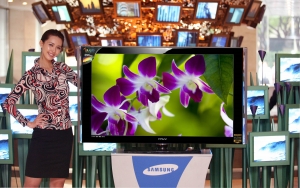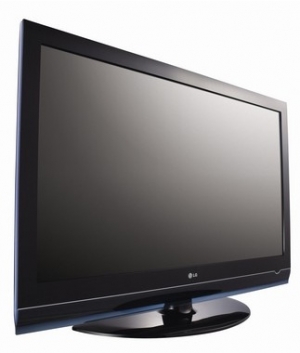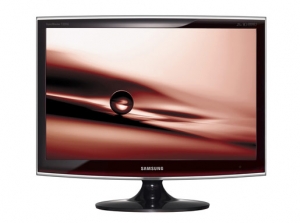
Sibling rivalry arises as children grow and compete for attention. As they reach different stages of development, children’s needs and wants affect how they help each other later in life. Without doubt, sibling rivalry lasts a lifetime. This is an old axiom that rings true through the ages.
Korea’s two leading electronics manufacturers, Samsung Electronics and LG Electronics, are such rivals competing to develop newer technologies to grab a bigger market share.
Korea’s electronics industry began in 1959 when GoldStar (predecessor of LG Electronics) assembled Korea’s first AM radios. In 1966, GoldStar produced the country’s first black-and-white TV sets. LG Electronics developed and sold Korea’s first digital TV in 1999.
This definitely gave LG Electronics a head start on Samsung Electronics, but the baby brother quickly became a worthy competitor in both domestic and overseas markets. Samsung soon caught up with LG by performing one feat after another. These two electronics giants have broken records in many sectors, developing and producing many of Korea’s first electronic devices and making inroads into overseas markets shoulder to shoulder as bona-fide rivals. Rivalry has naturally stimulated innovation and provided the basis for a strong competitive position in international markets.
Of all electronics appliances, TV has so remarkably changed people’s lifestyles and affected their home life. It has, therefore, become an essential necessity in people’s everyday lives. In addition to entertainment for families, it has emerged as a tool for delivery of information, including the latest technology trends. Since the United States test-telecast TV programs in 1931 and BBC's history making black-and-white TV programs in 1937, the TV industry has made rapid progress. In May 1956, Korea became the 15th country in the world to adopt black-and-white TV broadcasting .

In tandem with TV broadcasting, electronics manufacturers were busy assembling black-and-white CRT (cathode-ray tube) TV sets. Korea’s first TV was a 19” black-and-white CRT TV set produced by GoldStar in 1966. Despite being a latecomer, Samsung performed admirably. It crossed the production milestone of 10 million black-and-white TV sets in 1981, while topping the world list in terms of exports of black-and-white TV sets. On the back of Samsung’s performance, Korea became the world’s largest exporter and producer of black-and-white TV sets in 1982.
Color TV sets were first produced in the country in 1974, but people had to wait until 1980 for such TV sets to be released on the market and color TV broadcasting started. The start of color TV broadcasting prompted TV manufacturers to focus on finding new markets, which, in turn, encouraged them to further develop TV and monitor technologies.

As consumers continually want sharper definition and thinner screen, rival electronics manufacturers have been competing to get ahead of each other over how to meet consumer needs. This has naturally led them to develop the newest technologies, such as LCD (liquid crystal display), PDP (plasma display panel), and LED (light-emitting diode) displays. Liquid crystals were first found to have some interesting electro-optic characteristics in 1962. The LED was first invented in Russia in the 1920s, and introduced in the United States as a practical electronic component in 1962. And, the monochrome plasma display was invented in the United States in 1964. These three materials have characteristic properties, weaknesses and strengths of their own, depending upon how they are used.
Samsung and LG are good rivals in the development and production of TV displays, be they LCDs or PDPs. Both electronics conglomerates have their own competitive edge in each sector, while Samsung appears to have a clear lead in the new LEDs. Samsung calls its development of the LED early this year a “crystallization of Samsung’s success in TV development,” given that its development and release of the LED TV has contributed to boosting its market share conspicuously.

Apparently out of confidence and pride, Samsung was somewhat adventuresome in releasing its LED TV in the global markets throughout the world at the same time contrary to the market tradition. In the past, most manufacturers used to release their products on the market in advanced countries first, and then release them on the market in emerging economies several months later after carefully studying consumer responses.
Since 2004, when the sale of the LCD TV began in earnest, Samsung Electronics has grown 126 percent, slightly more than double the average growth rate of the global market (59 percent), in terms of revenue. It has grown a whopping 136 percent, compared to the world average rate of 86 percent, in terms of sales. Samsung TV has ranked top both in terms of revenue since 2006 and in terms of sales since 2007.
Samsung Electronics has recently released a new high-efficiency and slim LED monitor model “XL2370,” a second LED monitor following LG Electronics’. Samsung’s new LED monitor has a 5,000,000:1 contrast ratio and a rapid 2ms response time. LG has released LED backlight TV and monitor with a 2,000,000:1 brightness ratio, featuring two HDMI connectors as well as the usual DVI and features a 1680x1050 resolution. LG’s LED is an eco-friendly product for which no mercury or lead was used.

The LG Economic Research Institute, however, expressed worries in a recent report that with LCD prices stabilizing slowly and its production increasing rapidly, there will be a supply glut in the LCD market from either late this year or early next year. After all, breakthrough should be found in developing new technologies and new products that can suit consumer needs as quickly as possible, or maximizing the profit structure, reducing the costs and making capital investments.
Aiming for the world's top spot with a 30 percent market share by 2005, LG Electronics, meanwhile, developed a PDP module with the world's highest contrast ratio. But with the growth of the PDP module market slowing down, capital investment, which had dwindled over the few years, appears to be shrinking further this year. During the second half of last year, Samsung Electronics took over the PDP module business operations from Samsung SDI. Samsung has since focused on maximizing outputs and profits.
Meanwhile, LG Display gave active consideration to expanding its eighth-generation production line with an investment of more than W2 trillion (US$1.6 billion). If its plan proceeds smoothly, LG will have a higher-level LCD production level in the second half of next year. LG Display’s outstanding performance has put its rival, Samsung Electronics, on high alert.

Despite the uncertainty in the global economy, LG Display has been making investments aggressively due to short supplies in the global market of large-size LCD TV panels, laptop displays and monitors. LG appears to be determined to get ahead of Samsung Electronics in terms of mass-production of LCD displays in their competition to grab top place in the global market. Samsung also seems to fight back against LG’s offensives to gain top market position. A senior Samsung executive revealed a plan to give active thought to making a massive capital investment in an eighth-generation LCD production line in the second half of this year.
Samsung, as the world’s largest TV brand, has a 21.9 percent global market share, also coming in as the global top TV seller in the first quarter of 2009 for the 13 consecutive quarter. Samsung Electronics took up a 21.5 percent market share in terms of dollar-based revenue in the first quarter this year. Samsung was followed by LG Electronics with a 13.3 percent market share, which slightly outdistanced Japan's Sony by a mere 0.1 percent.


